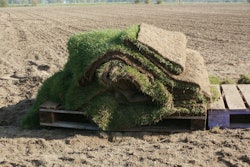
That would be an expensive mistake.
A few simple pre-winter maintenance steps can dramatically reduce the likelihood of engine failure and lower the cost of repairs when you need your mowers again come spring.
Here are 10 easy ways to prepare a lawn mower for winter or off-season storage:
1. Clean the deck and undercarriage
It may seem obvious but stripping away the excess dirt and grass clippings is the first step to proper off-season storage. A hose, putty knife and car wash detergent are sufficient tools for clearing grass and debris from the deck and undercarriage. Clean it down to the painted metal.
2. Degrease the mower
Spray a degreaser on oil stains and allow it to sit for 10 to 15 minutes before wiping it off with a clean cloth. Rinse with a hose to remove any excess oil.
3. Check the blade for dullness or damage
It may sound counterintuitive to repair or replace your mower’s blade before wheeling it into storage but doing so now will prevent you from forgetting to do so in the spring.
If the blade is bent, replace it, as a bent blade is a safety issue and can cause premature wear to the engine or spindle bearings. Similarly, a blade with dents or gouges should be replaced, as a damaged blade may increase the risk of debris such as pebbles being propelled at high speeds through the air. A dull blade tears grass, rather than cuts, giving a lawn a dried-out, brown look, and a blade that has already been sharpened twice should be replaced.
Only use the manufacturer-recommended blade listed in the owner’s manual. Never use a universal-fit blade; for safety and performance reasons, a lawn mower needs a blade designed for its specific make and model.
4. Determine if you should drain the fuel tank
Lawn mower instructions vary about draining or leaving fuel in the engine over an extended period of time. Read the owner’s manual for model-specific information.
If your lawn mower manufacturer recommends leaving fuel in the engine, be sure to use fresh fuel treated with fuel stabilizer to prevent clogging in the carburetor.
The most common cause of a lawn mower failing to start after being in storage is a carburetor clogged with buildup caused by stale fuel. That’s a fairly time-consuming and expensive fix, so it’s best to do this step right.
5. Clean the fuel cap
Use a paintbrush to brush away particles and buildup on the fuel cap. Do not spray cleaners or degreasers at the cap, as they can clog the cap’s small air vents. Before closing the fuel cap, inspect for any blockages; if you see any, replace the cap entirely.
6. Replace the spark plug
A spark plug should be replaced at least once every season, even if it appears to be working fine. People don’t realize how important the small spark plug is to the efficient operation of mowers.
Over time, a spark plug’s performance will degrade due to carbon buildup and a weakened electrode. This affects engine performance and requires the engine to use more fuel.
Spark plugs are sold pre-gapped, so installation is simple. Only the engine manufacturer’s recommended spark plug should be used, as using an alternative model can cause damage to the engine.
7. Lubricate bare metal to avoid rusting
To prevent rusting, use a lubricant like WD-40 or silicone spray on any exposed metal parts in the undercarriage. This will keep your mower looking new.
8. Clean or replace the air filter
Air filters prevent debris and dust from entering the lawn mower’s carburetor and engine. Foam filters may be cleaned with water and a small amount of detergent, but there is high risk of tearing. Pleated paper air filters are known to deteriorate quickly, so a full replacement is recommended.
9. Replace the oil
A mower’s oil should be replaced after every 50 hours of use. Like vehicle engine oil, it will darken with use due to carbon from fuel combustion, so it should be golden or amber in color when you check it.
Remember to use the oil recommended for your engine. Engine tune-up kits, which include replacement oil, make it easy to find exactly what you need. Old oil should be recycled; contact local small engine repair shops or auto parts stores about available programs.
10. Find the best storage location
Find a dry, covered location for your lawn mowers to rest, such as a garage, warehouse or shed, away from cleaning supplies or other chemicals that could damage the mower if spilled.
EDITOR’S NOTE: This article was written by Chris Zeisler.
Zeisler is a master technician at Repair Clinic. Repair Clinic technicians are available 24/7 online via live chat or phone at 800-269-2609.










